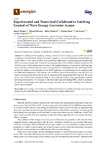Experimental and Numerical Collaborative Latching Control of Wave Energy Converter Arrays
| dc.contributor.author | Thomas, S | |
| dc.contributor.author | Eriksson, M | |
| dc.contributor.author | Göteman, M | |
| dc.contributor.author | Hann, Martyn | |
| dc.contributor.author | Isberg, J | |
| dc.contributor.author | Engström, J | |
| dc.date.accessioned | 2018-11-22T16:01:46Z | |
| dc.date.issued | 2018-11 | |
| dc.identifier.issn | 1996-1073 | |
| dc.identifier.issn | 1996-1073 | |
| dc.identifier.other | ARTN 3036 | |
| dc.identifier.uri | http://hdl.handle.net/10026.1/12848 | |
| dc.description.abstract |
<jats:p>A challenge while applying latching control on a wave energy converter (WEC) is to find a reliable and robust control strategy working in irregular waves and handling the non-ideal behavior of real WECs. In this paper, a robust and model-free collaborative learning approach for latchable WECs in an array is presented. A machine learning algorithm with a shallow artificial neural network (ANN) is used to find optimal latching times. The applied strategy is compared to a latching time that is linearly correlated with the mean wave period: It is remarkable that the ANN-based WEC achieved a similar power absorption as the WEC applying a linear latching time, by applying only two different latching times. The strategy was tested in a numerical simulation, where for some sea states it absorbed more than twice the power compared to the uncontrolled WEC and over 30% more power than a WEC with constant latching. In wave tank tests with a 1:10 physical scale model the advantage decreased to +3% compared to the best tested constant latching WEC, which is explained by the lower advantage of the latching strategy caused by the non-ideal latching of the physical power take-off model.</jats:p> | |
| dc.format.extent | 3036-3036 | |
| dc.language | en | |
| dc.language.iso | en | |
| dc.publisher | MDPI | |
| dc.subject | wave energy | |
| dc.subject | power take-off | |
| dc.subject | artificial neural network | |
| dc.subject | machine learning | |
| dc.subject | wave tank test | |
| dc.subject | physical scale model | |
| dc.subject | floating point absorber | |
| dc.subject | latching | |
| dc.subject | control | |
| dc.subject | collaborative | |
| dc.title | Experimental and Numerical Collaborative Latching Control of Wave Energy Converter Arrays | |
| dc.type | journal-article | |
| dc.type | Journal Article | |
| plymouth.author-url | https://www.webofscience.com/api/gateway?GWVersion=2&SrcApp=PARTNER_APP&SrcAuth=LinksAMR&KeyUT=WOS:000451814000174&DestLinkType=FullRecord&DestApp=ALL_WOS&UsrCustomerID=11bb513d99f797142bcfeffcc58ea008 | |
| plymouth.issue | 11 | |
| plymouth.volume | 11 | |
| plymouth.publication-status | Published online | |
| plymouth.journal | Energies | |
| dc.identifier.doi | 10.3390/en11113036 | |
| plymouth.organisational-group | /Plymouth | |
| plymouth.organisational-group | /Plymouth/Faculty of Science and Engineering | |
| plymouth.organisational-group | /Plymouth/Faculty of Science and Engineering/School of Engineering, Computing and Mathematics | |
| plymouth.organisational-group | /Plymouth/REF 2021 Researchers by UoA | |
| plymouth.organisational-group | /Plymouth/REF 2021 Researchers by UoA/UoA12 Engineering | |
| plymouth.organisational-group | /Plymouth/Users by role | |
| plymouth.organisational-group | /Plymouth/Users by role/Academics | |
| plymouth.organisational-group | /Plymouth/Users by role/Researchers in ResearchFish submission | |
| dcterms.dateAccepted | 2018-10-29 | |
| dc.rights.embargodate | 2018-11-30 | |
| dc.identifier.eissn | 1996-1073 | |
| dc.rights.embargoperiod | Not known | |
| rioxxterms.versionofrecord | 10.3390/en11113036 | |
| rioxxterms.licenseref.uri | http://www.rioxx.net/licenses/all-rights-reserved | |
| rioxxterms.licenseref.startdate | 2018-11 | |
| rioxxterms.type | Journal Article/Review |


